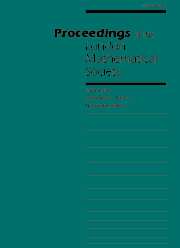Article contents
THE SCENERY FLOW FOR HYPERBOLIC JULIA SETS
Published online by Cambridge University Press: 23 July 2002
Abstract
We define the scenery flow space at a point z in the Julia set J of a hyperbolic rational map $T : \mathbb{C} \to \mathbb{C}$ with degree at least 2, and more generally for T a conformal mixing repellor.
We prove that, for hyperbolic rational maps, except for a few exceptional cases listed below, the scenery flow is ergodic. We also prove ergodicity for almost all conformal mixing repellors; here the statement is that the scenery flow is ergodic for the repellors which are not linear nor contained in a finite union of real-analytic curves, and furthermore that for the collection of such maps based on a fixed open set U, the ergodic cases form a dense open subset of that collection. Scenery flow ergodicity implies that one generates the same scenery flow by zooming down towards almost every z with respect to the Hausdorff measure $H^d$, where d is the dimension of J, and that the flow has a unique measure of maximal entropy.
For all conformal mixing repellors, the flow is loosely Bernoulli and has topological entropy at most d. Moreover the flow at almost every point is the same up to a rotation, and so as a corollary, one has an analogue of the Lebesgue density theorem for the fractal set, giving a different proof of a theorem of Falconer.
2000 Mathematical Subject Classification: 37F15, 37F35, 37D20.
- Type
- Research Article
- Information
- Proceedings of the London Mathematical Society , Volume 85 , Issue 2 , September 2002 , pp. 467 - 492
- Copyright
- 2002 London Mathematical Society
- 12
- Cited by


